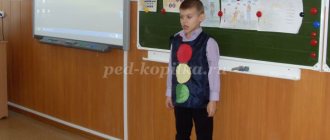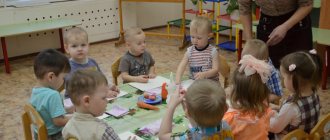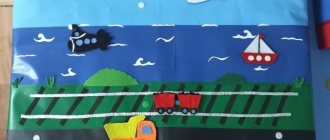Organization of labor in nature in the younger group
Contents of work Objectives
In a group room
1. Observations of a teacher caring for indoor plants.
Work in a corner of nature together with the teacher: when watering indoor plants, the teacher gives the children simple instructions - hold the watering can, put it in place, etc.
2. Consideration of the algorithm
3. Reading the ecological fairy tale “Green Friend” to children
4. Game situation “Let’s show Dunno how to care for plants”
The teacher draws the children's attention to Dunno and says that he also has a lot of plants, but for some reason they are dusty and sad. Let's show Dunno how to care for plants. The teacher reminds you of the rules for caring for plants and turns to Pinocchio so that he can also watch and remember. The children complete the task, the teacher helps them with advice during the work, talks with the children individually about the names of the plants.
5. Work in a corner of nature: watering plants
6. Labor: planting onions in a corner of nature.
The grandfather from the fairy tale “Turnip” comes to visit the children and asks them to help him grow onions.
7. Labor: wash plant leaves
8. Observation - experiment “With and without water.”
9. Observing the planting of a flower.
1. Form the concept of “houseplants”, highlighting the main characteristics: they grow at home, in pots, people take care of them. These flowers cannot live outside. Give an idea of one of the purposes of indoor plants: they are beautiful and decorate the room.
2. Reinforce the sequence of actions and their purpose when caring for plants.
3. To consolidate children’s knowledge about the conditions necessary for growing plants.
4. Introduce children to ways to keep leaves clean. To instill in children a caring attitude towards plants and caring for them.
5. Teach children to properly water plants (under the leaves); cultivate a desire to care for plants
6. Clarify children’s understanding of bulbs (they are round, yellow, have tops and roots); develop bulb planting skills (place in the hole, press firmly and sprinkle with soil, water); arouse interest in growing plants
7. Continue to teach how to wash plant leaves and cultivate a caring attitude toward plants.
8. Form concepts about the needs of plants, highlight environmental factors for the growth and development of plants (water).
9. Introduce children to one of the methods of propagating indoor plants - from one plant to two.
1. Harvesting vegetables in the garden (adult help).
2. Observation of the collection of large flower seeds
3. Collecting garbage and leaves in a certain place.
1. To form and strengthen in children an interest in work and a desire to get involved in it. Strengthen knowledge about vegetables.
2. Instill in children the skills to carry out work assignments, and encourage them to develop a desire to master these skills.
3. Teach to maintain order and cleanliness in the kindergarten area.
1. Removing dry branches from the site.
2. Sweep snow from benches and buildings on the site.
3. Sweeping paths on the site.
4. Observing the work of a janitor.
1. Continue teaching children to maintain order in the kindergarten area.
2. Teach children to realize the importance and necessity of work.
3. Teach children to sweep paths with a broom, to see the result of their labor.
4. Foster respect for the work of a janitor.
1. Shove snow towards trees.
2. Clearing feeders, feeding birds.
1. To instill in children a desire to take part in work activities as much as possible.
2. Teach children to take care of birds and help them during the cold season.
1. Put the feeders back into storage.
2. Put the garden in order - clearing debris and stones.
3. Cleaning dry grass in the garden.
1. Teach children to take care of equipment, put it in order, and put it away for storage.
2. Teach children to realize the importance and necessity of work.
3. Feel a sense of joy from the achieved result, praise the children at the site for their work.
1. Cleaning the area of debris.
2. Draining the area - allowing streams to pass through.
3. Spreading snow to melt quickly.
4. Taking out toys and cleaning them after playing. 1.2. Continue to support the desire to help adults, to work side by side without interfering with each other.
3.4. To form activity, the ability to overcome difficulties, to teach to feel independent and skillful.
1. Observation of digging beds.
2. Observing the digging of flower beds.
3. Planting onions, peas, beans.
1.2. Continue to strengthen children’s interest in work, cultivate a desire to participate in work as much as possible.
3. Involve children in planting onions, peas, beans, give the child the opportunity to assert himself and feel skillful.
1. Observation of the work of adults (help as feasible)
1) weeding in the garden
2) loosening beds, flower beds
1. Enrich children's understanding of plants, teach how to care for them, and support the desire to help adults.
Card file of work assignments in a corner of nature. Card file of the world around us (junior group)
Card 29"Introduction to Balsam"
Target:
Continue to teach children to describe plants, while distinguishing the differences and similarities between them and the most characteristic features of their appearance. Teach description according to the plan suggested by the teacher. Strengthen children's knowledge of plant names.
Introduce them to a new plant - balsam, give it its common name “light”.
Explain the name of the plant. Maintain and strengthen children's interest in indoor plants and observing them.
Progress of the lesson:
Children sit on chairs.
Educator - Guys, Mishka came to visit us. He says he knows nothing at all about houseplants. Let's tell him a little (children: “come on”). Bear, sit down more comfortably and listen carefully.
Educator - Look and tell me what’s on my table? (children's answers).
— What are these indoor plants called? (children's answers), for example (geranium, ficus). What are their leaves in shape, size, color, surface? Do plants have flowers?
What are they and how many are there? (children's answers).
Educator - Guys, look carefully and tell me what kind of indoor plant I am holding in my hands? That's right, it's a ficus, let's look at it.
Teacher - What size is it? (children’s answer: “big, like a tree”), answering the teacher’s questions, the children establish that the stem of this plant is straight, tall, the leaves are large, oval in shape, dark green.
Educator - What else can you say about the sheet? (offering to touch the leaf)
- What does it feel like? (children's answers: smooth, shiny).
After this, they summarize: what everyone said about the plants, how you can characterize the plant as a whole.
The teacher invites the children to also talk about other plants, compare them with each other in size, shape and color of leaves and other characteristics.
Teacher - Well done, guys! You see, Mishka, how much the guys know.
Mishka - Yes, well done! Thanks to you guys, I learned a lot about plants. How do they differ from each other, what kind of leaves do they have, what color. I used to think that all plants are the same, but it turns out that this is not true at all.
Teacher - Guys, I have a surprise for you. I brought you a new houseplant, would you like to meet it? (the children's answer is, of course, N E T). Are you Mishka?
Educator - Then watch and listen carefully. OK? I am holding in my hands a new plant called “Balsamin”, but people simply call it “Ogonyok”.
Teddy bear laughs at the name "light"
Educator - Yes, Mishka, don’t laugh, this flower is called “Ogonyok”. Do you want to know why? (children's answers). Because it has a lot of small red flowers.
Bear - Well, now it’s clear.
Educator - Guys, look at the flower and tell us about it the same way you talked about other plants. (Children examine the “light” and describe it.)
Educator - Do you like it, “light”? He will remain in our group. What place will we find for it? (children's answers).
That's right, the “light” will grow well where there is a lot of light and sun. Now let’s compare the “light” and another plant – a friendly family. Are they similar? How are they similar? What kind of leaves do they have? (children's answers).
By asking questions, the teacher encourages children to characterize each plant as a whole, and comparing it with others makes it possible to clarify the characteristics characteristic of each plant. At the end of the lesson there is a didactic game.
Educator - Now we will play with you. Want to? (children’s answer:….)
One of the children “drives”, and the other children hide some plant.
The child, turning around, must guess which plant was removed. At the end of the lesson, the teacher evaluates the children’s knowledge, and the children put small plants in their places.
Educator - Well, Mishka, the guys and I told you about indoor plants. Did you like it?
Bear - YES! Thank you very much guys. Now, I can tell my friends a lot about indoor plants.
Preview:
Summary of educational activities on labor education in a corner of nature
Author: Natalya Vasilievna Masalskaya, Municipal Educational Institution No. 163, Kemerovo “We water indoor plants - we do good deeds”
(second junior group)
Types of children's activities: gaming, communicative, cognitive and research.
Goal: acquaintance with violet, creating conditions for labor education in a playful way.
Educational: to consolidate and supplement children’s knowledge about plant care techniques: to teach the difference between a watered plant (dark, damp soil) and an unwatered plant (light, dry soil); Developmental: to develop the ability to perform work in a certain sequence. Educational: continue to cultivate interest and love for plants, the desire to care for them.
Vocabulary work. Encourage students to use words in speech: violet, care, water, wipe leaves, smooth, shiny.
Daily care of plants in a corner of nature; knowledge of plant names; ficus, consideration of visual and didactic material on the topic: “Indoor plants” (Flowers).
Materials and equipment:
On the teacher’s desk there is a violet plant (specimens) and a watering can with water. There are children's chairs and oilcloth children's aprons in front of the table.
Contents of organized activities for children:
(Children are next to the teacher)
Educator: Guys, do you know what good deeds are? (Children answer) Yes, guys, good deeds bring joy to everyone, lift everyone’s spirits, take them away from trouble, etc. Tell us what good deeds you have already learned to do (wiping dust from toys, untying each other’s shoelaces, laying out pencils, plasticine, boards for activities, watering indoor plants, etc.).
— When we water and wash a flower, to whom are we doing a good deed? Children: flower (plant).
- That's right, without our care the flower will not grow and bloom.
Educator: guys, let's see who came to us?
Children: girl daisy.
Educator: That’s right, this is a girl called Daisy.
Girl Romashka: Hello, guys!
Children: Hello, Daisy Girl!
Educator: Guys, what is the Girl holding a daisy in her hands?
Children: a pot with a houseplant.
Educator: Yes, guys, this is a pot with a houseplant that has limp, drooping leaves. What is the name of this plant?
Educator: Guys. This houseplant is a violet.
Girl Chamomile: No matter how much I washed this plant, it still remained somehow not beautiful and sad. How to help the violet plant?
Educator: What needs to be done with the plant to make it beautiful again?
Children water the plants and place them in a sunny place.
The teacher invites the children and Girl Romashka to go and sit on the chairs.
Educator: In front of you, children, are plants. What is the name of this plant?
Educator: Look: what kind of soil does this (show) plant (which stood on the teacher’s table), what color?
Educator: come and touch the ground. What does it feel like?
Educator: Now look at the soil of the other plant (which the Chamomile Girl brought). Same color?
Children: No, light.
Educator: come and touch the ground. What is she like?
Educator: Which of these plants do you think has already been watered and which has not?
Children: The one that stood on the table was watered, but the one that the Chamomile Girl brought - no, it was not watered.
— How can you find out whether a plant needs to be watered? (By the color of the earth and to the touch).
Girl Chamomile: Can I water the plant?
Educator: Of course, come and water the plant.
Girl Chamomile: I know how to do this, and suggests pouring a bucket of water on top of the plant.
Educator: You can’t water plants like that. Children, why can’t this be done? (Answers from children and teacher).
— You can flood the plant, pour water on the floor, etc.
The teacher asks the child to come up and water a plant that has not been watered. Is it right. chose a plant? Is he watering it correctly? The teacher comments on his actions and encourages: . holds the watering can correctly, the spout of the watering can rests on the edge of the pot. In the absence of moisture (water), the plant (leaves, stem) lose their elasticity and droop. You need to water until water appears on the tray. . So we watered your plant. Now we will put the violet in a sunny place, because... flower - will grow well where there is a lot of light and warmth.
- But our guys not only know how to water the plant, but also wash them well (wipe the leaves). The teacher shows a houseplant known to the children (ficus) and asks them to remember its name.
(Children answer) saying the name of the plant.
Then the teacher asks the children what the “ficus” looks like, a tree or grass, what kind of leaves it has, large or small, what color are they? (Children answer).
- We took care of the plant (ficus), watered it, washed it - and now it has grown - it has become like a small tree, it has large green smooth leaves.
(Children complete the task), the teacher comments: “Take rags, wet them, wring them out so that water does not drip from them, straighten them; place a leaf on the palm of one hand and, supporting it from below, slowly and carefully run the cloth over it in one direction from the petiole to the end at the top, and then at the bottom. You need to wash it carefully so that the leaf does not break. Rinse the cloth and also wipe the next sheet.”
- And now all the children will wipe the leaves of the plants.
The teacher invites the Camomile Girl to help the children.
- Well done, guys, they work well (praises the teacher).
Teacher: “We’ve done our work, rinse the cloths, wring them out, we’ll hang them on the radiator to dry. Next time we wash the plants, the cloths will be clean.”
After all the leaves of the plants are clean, the teacher invites one of the children to take watering cans and water the plants that have not yet been watered today. Watering the onion is our garden.
Reading the poem by I. Voronko “Don’t stop me from working.”
Don't stop me from working
I'll bring some water
And well water
Of course, I’ll treat everyone.
He drinks water too!
The children work, the teacher helps them with advice if necessary. Then the teacher offers to look at the plants - how clean and beautiful (well-groomed) they have become.
The teacher, chamomile and children arrange indoor plants in a corner of nature.
Game "Find the flower".
Goal: to teach children to correctly find and name flowers, develop memory, thinking, and cultivate a love of nature.
(The teacher shows a card with a picture of a flower - the children find the same flower - in a corner of nature.)
At the suggestion of the teacher, the children give Pinocchio a clean, blooming and well-groomed plant - balsam (light) with the request that Pinocchio does not forget to care for the plant.
Chamomile thanks and says goodbye to everyone.
MAGAZINE Preschooler.RF
Environmental education. Labor activity in a corner of nature. Lesson notes for children of the first junior group. Topic: “I have a garden - vitamins all year round.” Report for all age groups.First junior group.
In the first ml. gr., children, indoors and on the site, watch how an adult cares for plants and animals. The task of educators is to involve children in joint actions to care for natural objects. Develop a cognitive interest in natural objects, develop a positive attitude and skills of careful handling, the ability to notice the beauty and individuality of each living creature. Since the child’s attention in this age period is not stable, it is advisable to involve children in performing one-time basic tasks: (politely and affectionately ask to bring a scoop, help carry a tray for molds). The order must be really important, because Children at this age already feel when their activities are not needed by anyone.
Second junior group.
In the second ml. gr. household chores, just like in the first ml. gr., comes down mainly to carrying out simple individual assignments. Thus, we cultivate the desire to take part in caring for plants and animals in the corner of nature and on the site. We teach them to notice changes that have occurred in plants they know (lilacs have bloomed, fruits have appeared on the apple tree, etc.) We teach them, with the help of an adult, to feed fish, birds, water houseplants, etc., and also develop skills in handling equipment. The leading type of activity at this age is more than one repetition, sensory examination and practical action. Children's attention is still not stable, so activities should not be too long and monotonous. An adult introduces children to indoor plants, in which the trunk, leaves and their names are clearly distinguishable. These are begonia, various types of ficus, balsam, coleus.
The teacher involves children in caring for plants, shows how to clean the leaves of ficus, chlorophytum, and spathiphyllum from dust, explains that plants hear us and feel our attitude towards them, therefore, when caring for them, you need to talk to them kindly. Children of this age, with the help of an adult, are able to grow green onions from bulbs. For this age group, turtles, canaries, and fish are kept in a corner of nature.
While observing the inhabitants of the aquarium with the kids, the teacher explains what kind of food they like and how many times a day they need to be fed.
Next time he will definitely give two or three children the opportunity to feed the fish themselves. Kids watch the teacher as he plants aquatic plants, places pebbles that support the plants, partially changes the water, cleans the filter, etc.
When getting to know the inhabitants of a living area, an adult can tell children excerpts from fairy tales and read out works by children's writers.
Middle group.
On Wednesday. gr. Household work begins to occupy a significant place in children's lives. The main form of its organization is assignments, which make it possible to systematically involve all students in a variety of work activities. We form the beginnings of a responsible attitude towards the assigned task (the ability and desire to complete the work started), the desire to do it well.
Encourage initiative in helping friends and adults. We deepen knowledge about the needs of living beings. We teach children to systematically care for the inhabitants of a corner of nature. In the corner of nature, zonal geranium, chlorophytum, and asparagus are added to the plants known to children. The teacher explains that different plants have different needs for water. Teaches you to recognize wet or dry soil by the color of the earth and by touch. Shows how to water a particular plant. You can trust children to water on their own without secretly supervising the completion of the task.
From late autumn to the end of March, onions and herbs are grown for birds.
(If there are any). Since February, children can watch the work of a teacher in growing seedlings of peppers, tomatoes, germinating seeds, planting, and picking. Towards the end of winter, you can put a few branches of a tree or shrub in water and draw the attention of preschoolers to how they react to heat and water. In the spring, the teacher introduces children to methods of plant propagation (using the example of chlorophytum). In the second half of the year, the teacher gives children not only individual assignments, but also collective ones. When giving instructions, it is necessary to take into account the characteristics of children: those whose attention is not stable should be given simple tasks (feed the fish). Those who know how to finish what they start are given more complex tasks (watering plants, wiping leaves, loosening the soil). Labor efforts are necessarily assessed by the teacher.
Senior group.
For children in the older group, the teacher teaches them to carry out various tasks related to caring for animals and plants in a corner of nature. Trains you to perform the duties of an attendant in a corner of nature: watering plants, loosening the soil, etc. Draws children's attention to the fact that well-groomed plants look beautiful and are pleasing to the eye. It is important to teach your child to listen to a task, think through a work plan, not interfere with others’ work, help his comrades, not give up on something he has started, and do not be shy about asking for help. New plants appear in the corner of nature (tradescantia, indoor grapes, sansevieria, crinum, Uzalebar violet, rotius). The teacher tells children about the living conditions of plants in nature and how to care for them. For example: in winter, their growth noticeably slows down, watering is carried out less frequently, and plants are inspected more often in order to notice pests in time. Attracts preschoolers to treat trunks and leaves with soapy water. From the end of January to the beginning of February, children are involved in growing vegetables from seeds, seedlings, and from the end of March, flower crops. In the spring, the teacher introduces children to another method of plant propagation: leaf blades (in violets). Tells you how to find out if your indoor plants need replanting. From the beginning of October, the teacher introduces duty in a corner of nature (2-3 people each). On the chart, which is located in a prominent place in the corner of nature, the teacher gives marks for duty in the form of drawings opposite the names. It is especially important to note that there are no bad grades, only “good” and “excellent” .
Preparatory group.
The work of children of this age is more independent. All children can take part in joint work. Children can carry out various tasks related to caring for animals and plant corners of nature (watering plants, loosening the soil, washing feeders, preparing food for fish and birds, etc.). In the fall, the teacher involves children in replanting flowering plants from the ground into a corner of nature. In the corner of nature, children are now on duty for 2-3 days, so they treat their work more responsibly: what was not completed yesterday will have to be completed tomorrow. The teacher teaches them to distribute responsibilities among themselves. The work of growing green onions is now carried out by those on duty. A corner of nature for children of this age now does not cause difficulties. In the preparatory group, new plants appear in a corner of nature: (cyperus, saxifrage, cacti). In February, an introduction to bulbous plants is held. Work continues to familiarize preschoolers with various methods of plant propagation (tendrils, leaf blades, cuttings, rhizomes, etc.) Children's knowledge of the diversity of the plant world is being consolidated.
Educator: Korchevnaya Yu.V. MBDOU No. 57 “Country of Childhood” M.O. Khimki 2015
Lesson notes for junior group 1. Work activity in a corner of nature “I have a vegetable garden - vitamins all year round”
Target:
- Clarify and consolidate children's knowledge about vegetables, how to grow them, talk about the need for light, moisture and heat for plant growth.
- Learn to recognize vegetables by description.
- Talk about the health benefits of onions.
- Foster a desire to plant and care for plants.
Preliminary work:
- Examination of seeds (parsley, dill, onion sets).
- Planting seeds, observing and caring for seedlings.
- Watering and loosening the soil.
- Reading proverbs, sayings and riddles about onions and other vegetables.
Material:
- Cups with loose soil, bulbs for each child, a watering can with water.
- Cippolino doll, illustrations of vegetables, dill seeds, parsley.
Course of the lesson: Children sit in a semicircle.
Children, today guests came to us to see how you can work in our natural corner... (let's say hello)
Guys, but these are not all the guests, yesterday on the way home, I met an onion boy, his name is Chippolino, we talked about plants, about nature, about animals. I told him that in our group there is a corner of nature and invited Cippolino to visit us.
There's a knock on the door. Cippolino appears and says hello. Then there is a dialogue between Cippolino and the children.
Cippolino:
- I heard that in your kindergarten there is a living corner and
I want to find out who lives in it. Tell me, please!
The teacher directs the children's answers to questions.
-Who lives in our living corner? (rabbit Basya, budgies, lovebirds, fish, small Amadina birds, gerbils).
-And recently another rabbit appeared, his name? (Vasya)
-How do we care for our animals? (we feed, watch how adults clean the cages, etc.)
-What else is there in our living corner? (plants).
-What plants? (Ficus, Begonia, Impatiens, Saxifraga)
-How do we care for our plants?
(wipe leaves, water)
Cippolino praises the children and suggests making a nature corner in the group.
Cippolino: Guys, what is in your corner of nature?
Children answer together with the teacher (earth box, earth, seeds, watering can)
Cippolino: children, what vegetables do you know?
Children: (with the help of illustrations they name: cucumber, pepper, tomato, eggplant, cabbage, carrot).
-Tell me, can you solve riddles? (Yes).
The Maiden hid in the ground. A braid sticks out of the ground. I will deftly pull out the Red (Carrot.)
This is not a Fragrant toy at all... (Parsley)
No windows, no doors. Is the room full of people? (Cucumber)
The grandfather sits, wearing a hundred fur coats, and whoever undresses him sheds tears. (Onion)
Cippolino: praises the guys.
Cippolino talks about the benefits of onions and their healing qualities.
— It’s not for nothing that people say onion is a friend to health. Onion and bath rule everything. Onions cure seven ailments.
-Guys, since onions are so useful, let's plant them in the ground and grow them.
The teacher puts Cippolino on a chair and goes to the table where they have prepared (a box for soil, soil, seeds, a watering can). He pours soil into cups and, together with the children, plants onions, dill and parsley. After planting, Cippolino says goodbye to the children and promises to come visit when the harvest grows.
PHOTO
| Next > |
On the topic: methodological developments, presentations and notes
MBDOUTSRRDS 1 category No. 6 “Berezka” Summary of direct educational activities on labor education in the preparatory group. Date: 12/19/12 Educator: Yakovenko A.A. TOPIC: “Sun.
Synopsis of direct educational activities on labor education on the topic “Let's teach Pochemuchka to wash dishes.”
Summary of an open event for city teachers.
The notes will help educators clearly and simply explain to children how to work with a needle and thread, which is difficult for their age.
The notes will help educators teach children to correctly describe indoor plants and properly care for them.
Lesson in the preparatory group “Preparing fruit salad” - introducing you to the profession of a cook.
Topic: “Work in a corner of nature” Purpose: To clarify and consolidate children’s knowledge about the correct techniques for caring for indoor plants. Objectives: Educational: 1. Perfect.
Summary of OOD on the organization of labor activities for children in the younger group “Work in Nature”
Yulia Kuznetsova
Summary of OOD on the organization of labor activities for children in the younger group “Work in Nature”
Author: Yulia Kuznetsova
Summary of OOD on the organization of labor activities for children in the younger group
Type of work : Work in nature
Form of organization : Collective
Purpose: To introduce children to ways of caring for indoor plants and equipment.
Educational: to form ideas about different types of work ; consolidate knowledge about the basic needs of indoor plants; and various ways to care for them.
Developmental: develop speech, attention, thinking; develop gross and fine motor skills, tactile perception.
Educational: cultivate a caring attitude towards nature , a desire to help adults and participate in joint work .
Methods and techniques: encouragement, instruction, surprise, explanation, demonstration, reminder.
Equipment: indoor flowers, flower (ficus)
with drooping and dusty leaves, watering cans, aprons, rags.




